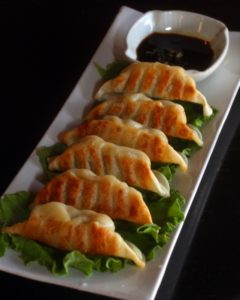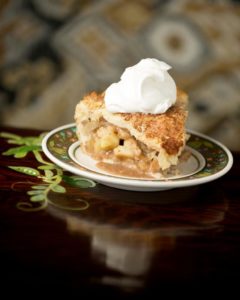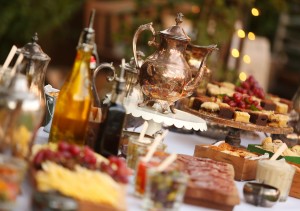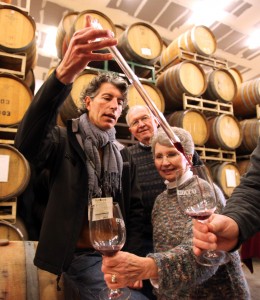Auteur Wines, 373 First St. West, Sonoma, 707-938-9211, auteurwines.com
In a little cottage off the Sonoma Plaza, Auteur offers intimate seated tastings of five of its exquisite wines, by appointment daily. The brand of winemaker Kenneth Juhasz, who also consults for The Donum Estate, Auteur is all about vineyard-designated Chardonnay and Pinot Noir from Sonoma and Mendocino counties.
Banshee Wines, 325 Center St., Healdsburg, 707-395-0915, bansheewines.com
One of the newer additions to Healdsburg’s downtown wine-tasting scene, Banshee has created a cozy enclave of wine and art, open into the evenings for lounging. Wines are available by the glass and bottle at retail prices; more formal tastings are available, paired with bites from Healdsburg Shed.
Benovia Winery, 3339 Hartman Road, Santa Rosa, 707-526-4441, benoviawinery.com
In the heart of the Russian River Valley, Benovia is open daily by appointment only, but worth the call to visit and taste current-release Chardonnay, Pinot Noir, Zinfandel and Grenache made from several estate-managed vineyards.
Bella Vineyards & Wine Caves, 9711 West Dry Creek Road, Healdsburg, 866-572-3552, bellawinery.com
Duck into Bella’s cozy caves to taste, and on the weekends, enjoy small bites from the winery’s stellar chef, Bruce Frieseke. Cave and vineyard tours can be arranged by appointment with one week’s notice.
Buena Vista Winery, 18000 Old Winery Road, Sonoma, 800-926-1266, buenavistawinery.com
Historic Buena Vista has refashioned its wine caves into a darkened, romantic spot for barrel tasting and touring, and a section of the cave can be reserved for private, by-appointment tastes of library wines and barrel samples. Don’t miss the Champagne Cellars (kid-friendly and there is no charge) where the winery’s history can be further explored.
Chateau St. Jean, 8555 Sonoma Highway, Kenwood, 707-833-4134, chateaustjean.com
With plenty of food and gifts to buy from its well-stocked tasting room, the best reason to visit this venerable winery right now is that it’s celebrating 40 years of producing its Bordeaux-style blend, Cinq Cepages; the 2010 vintage has just been released. Every January, the winery hosts a popular Crab and Chardonnay party. Sign up soon.
DeLoach Vineyards, 1791 Olivet Road, Santa Rosa, 707-526-9111, deloachvineyards.com
Producer of predominantly Russian River Valley Pinot Noir and Zinfandel, DeLoach affords visitors the opportunity to learn the philosophies of Biodynamic farming and take part in two unique experiences available daily. The M.F.S. Blending Experience ($100) is a 90-minute lesson in blending, bottling and labeling your own Pinot Noir. The Magic of Wine and Mustard ($40) explores the history of mustard in Burgundy, France, and includes a stroll through the vineyard and garden, the chance to make your own mustard from Dijon seeds, and a pairing of mustard-inspired food with a flight of DeLoach wines.
Dutcher Crossing Winery, 8533 Dry Creek Road, Geyserville, 866-431-2711, dutchercrossingwinery.com
This quiet, comforting winery with a fireplace in its tasting room, overlooks its own magnificent Dry Creek Valley vineyards, and produces a slew of fine wines, from Merlot and Cabernet Sauvignon to port and Petite Sirah. You might find winery dog Dutchess lounging near the fire or hanging out in the garden picnic grounds.
Fritz Underground Winery, 24691 Dutcher Creek Road, Cloverdale, 707-894-3389, fritzwinery.com
Step into Fritz’s subterranean winery, complete with warming fireplace, and enjoy its red blends, award-winning Zinfandels, fine estate rosé and late-harvest wines. By reservation, winemaker Brad Longton will even show you how to blend your own Pinot Noir ($175 a person).
Handley Cellars, 3151 Highway 128, Philo, 707-895-3876, handleycellars.com
The stomping ground of Mendocino County wine pioneer Milla Handley, Handley Cellars is the place to taste Chardonnay, Pinot Noir, Zinfandel and Alsatian varietals, including Riesling, Pinot Blanc, Pinot Gris and Gewürztraminer. The tasting room includes Handley’s impressive collection of international folk art. The first weekend of every month takes a page from her collection, offering “Culinary Adventures,” a pairing of Asian, African and New World cuisine with her wines.
Harmonique Wines, 14501 Highway 128, Boonville, 707-895-9300, harmoniquewine.com
Recently opened by owners Bruce and Moira Conzelman to celebrate the release of three aged Pinot Noirs made by winemaker Robert Klindt, the Harmonique tasting room is within the John Hanes Fine Art Gallery, across from the Boonville Hotel. Enjoy the winery’s 2007 Delicacé Pinot Noir from the Ferrington Vineyard, 2007 The Noble One Pinot Noir from the Klindt and Wiley vineyards, or 2007 Elegancé Pinot Noir, a blend from all three vineyards. The winery also offers an unoaked Chardonnay.
Hartford Family Winery, 8075 Martinelli Road, Forestville, 707-887-8030, hartfordwines.com
Tucked away in the woods, Hartford is a consistent high-quality producer of Pinot Noir, Chardonnay and old-vine Zinfandel, sourcing grapes from the Green Valley sub-appellation of the Russian River Valley where it is based, and from other cool locales such as Anderson Valley. Seated in-depth tastings, including some with food pairings, can be arranged by appointment.
J Vineyards & Winery, 11447 Old Redwood Highway, Healdsburg, 707-431-5400, jwine.com
A glass of bubbly is always a good thing, and this is a well-appointed spot at which to have it, as well as taste J’s Pinot Noirs and Chardonnays, and the very rare J Pear Liqueur. The J Bubble Room will pair wines with exquisite, locally sourced dishes.
Joseph Phelps Freestone Vineyards, 12747 El Camino Bodega, Freestone, 707-874-1010, josephphelps.com
On the way to the coast, Freestone Vineyards makes what you would expect — cool-climate Pinot Noirs and Chardonnays — and the tasting room will also pour selections from parent winery Joseph Phelps Vineyards, the Napa Valley producer of Cabernet Sauvignon and the famous Insignia proprietary red blend. On the second Sunday of every month, Freestone features local foods paired with the Sonoma Coast and Napa Valley wines.
Ladera Vineyards, 150 White Cottage Road South, Angwin, 707-965-2445, laderavineyards.com
Ladera is on the site of one of Napa Valley’s “ghost” wineries — an 1886 stone building built for gravity-flow winemaking. The Howell Mountain producer offers daily tastings of its current-release wines, as well as two-hour estate tours (11 a.m. and 2 p.m.) that delve deeply into the winery’s history, vineyards and wine caves.
Lambert Bridge, 4085 West Dry Creek Road, Healdsburg, 707-431-9600, lambertbridge.com
Lambert Bridge offers comfort and warmth in the wintertime, with a fieldstone fireplace roaring in the redwood-paneled tasting room. Then there are the dogs, a motley crew usually on hand, and the Barrel Room Wine and Food Pairings, during which Lambert Bridge’s richly elegant Cabernet Sauvignons and Zinfandels are poured with seasonal bites to match. Do a Signature Tasting on the weekend and you’ll be seated in the candlelit barrel room for a sampling of five small-lot wines.
Landmark Wine, 101 Adobe Canyon Road, Kenwood, 707-833-0053, landmarkwine.com
In the shadow of Sugarloaf Ridge State Park, Landmark makes Chardonnay (including the famous Overlook bottling) and Pinot Noir, and is increasingly becoming known for its Rhone-inspired reds, including Syrah and Grenache. In addition to its tasting room, the winery offers picnic spots and bocce courts.
Merry Edwards Winery, 2959 Gravenstein Highway North, Sebastopol, 707-823-7466, merryedwards.com
Winemaker Merry Edwards is a pioneer in Russian River Valley Pinot Noir, excelling at coaxing rich berry flavor and voluptuous texture from the grapes. She also produces some of the best Sauvignon Blanc in the state, and has recently added Chardonnay to her lineup. Don’t miss the opportunity to discover her skill and view some of the vineyards surrounding the winery.
Odette Estate, 5998 Silverado Trail, Napa, 707-224-7533, odetteestate.com
Owned by the PlumpJack Winery guys (Gordon Getty, Gavin Newsom and John Conover), Odette is in Napa Valley’s Stags Leap District and on the path to becoming LEED-certified. With 18,000 square feet of caves, some of the first modern versions dug in Napa Valley, Odette makes for an intriguing visit, with great Cabernet Sauvignon-based wines on offer.
Partake by K-J, 241 Healdsburg Ave., Healdsburg, 707-433-6000, partakebykj.com
This is a novel concept in tasting rooms, in that Partake is as much about the food (much of it sourced from the Jackson Estate’s gardens and orchards) as it is the wine itself. Take advantage of this delightful concept and step in for seasonal bites made to match specific flights of wine, from Sauvignon Blanc to dessert wines and lots in between. Reservations are recommended.
Paul Mathew Vineyards, 9060 Graton Road, Graton, 707-865-2505, paulmathewvineyards.com
This tiny operation produces Pinot Noir and Chardonnay, as well as the much rarer Valdiguie, a light-bodied red akin to Napa Gamay and sourced from the Turner Vineyard in Knights Valley. Also look for the winery’s ongoing schedule of Foodies Seminars, events held once a month with a focus on local food and wine.
Porter Creek Vineyards, 8735 Westside Road, Healdsburg, 707-433-6321, portercreekvineyards.com
Here is an old-school tasting room in terms of its simplicity, but there’s nothing simple about Porter Creek’s wines, which are intriguing and complex, made from organically grown grapes from hillside vineyards. In addition to Russian River Valley Pinot Noir and Chardonnay, enjoy Viognier, Carignane, Syrah and Zinfandel.
Ram’s Gate, 28700 Arnold Drive, Sonoma, 707-721-8700, ramsgate
winery.com Ram’s Gate was designed for lingering, with a host of spacious sitting areas, many of which are grouped around a fireplace. Then there’s the food, prepared to order by the on-staff chef for seated, guided tastings. Order a picnic lunch to take into the vineyard or out by the pond. The wines alone are a reason to stay, a collection of single-vineyard Pinot Noir, Syrah, Chardonnay and even a brut bubbly.
Red Car Wine, 8400 Graton Road, Sebastopol, 707-829-8500, redcarwine.com
Open daily, Red Car is a sweet spot to taste Pinot Noir, Chardonnay and Syrah, and a particularly good choice in winter. With inspired labels on many of its bottles, look for its The Fight Syrah, made from Gray’s Town Vineyard in the Sonoma Coast appellation, close to the winery; it’s a gorgeous expression of earthy mushroom, blueberry and dark chocolate.
Ridge Vineyards / Lytton Springs, 650 Lytton Springs Road, Healdsburg, 707-433-7721, ridgewine.com
The mighty Ridge is a perfect place to stop in winter, for its structured Zinfandels and Cabernet Sauvignons that are worth seeking out for occasions special and not. The tasting room is open daily, but reserve ahead for a Century Tour and Library Tasting, which might include an older vintage of Monte Bello Cabernet Sauvignon, Ridge’s most famous wine.
Saracina Vineyards, 11684 Highway 101, Hopland, 707-744-1671, saracina.com
John Fetzer and his wife, Patty Rock, have created a lovely destination getaway on the outskirts of Hopland. Practitioners of biodiversity, they have 600 acres that include grapevines, olive groves and ponds, and the cave is a cozy option for tasting the wines in winter. Bottlings include Malbec, Petite Sirah and an Anderson Valley Pinot Noir.
Schramsberg Vineyards, 1400 Schramsberg Road, Calistoga, 800-877-3623, schramsberg.com
Among the first in California to specialize in sparkling wine, Schramsberg occupies hallowed, historic ground, home to the oldest hillside vineyards in Napa Valley and some of the first caves dug for storing and aging wine. Take a tour by appointment, and don’t miss the Mirabelle Brut Rosé and other gorgeous sparklers before moving on to taste the J. Davies Estate Cabernet Sauvignon and Pinot Noir.
Stonestreet Alexander Mountain Estate, 7111 Highway 128, 707-473-3333, stonestreetwines.com
Located near Alexander Valley’s popular Jimtown Store, Stonestreet excels in mountain-grown Cabernet Sauvignon, Chardonnay and Sauvignon Blanc, and invites visitors to taste through its single-vineyard bottlings. Carve out extra time to take the two-hour Mountain Excursion and Picnic ($90; 10:30 a.m. Friday, Saturday and Sunday), a revelatory traipse through Stonestreet’s 6,000-acre estate, with lunch and wine.
Thomas George Estates, 8075 Westside Road, Healdsburg, 707-431-8031, thomasgeorgeestates.com
Set in a converted 1920s-era hop kiln, Thomas George specializes in Russian River Valley Pinot Noir and Chardonnay from specific, sought-after sites, and limited amounts of Sauvignon Blanc, Pinot Blanc, Zinfandel and Syrah. Expect to see dogs and sheep during your visit.
Tricycle Wine Partners, 23568 Arnold Drive, Sonoma, 707-255-4929, tricyclewineco.com
The newest addition to Cornerstone Gardens, Tricycle makes a range of high-quality wines, from its rich Obsidian Ridge Cabernet Sauvignon from Lake County, to Kazmer & Blaise Pinot Noir and Chardonnay from Carneros, to the Molnar Family single-vineyard wines from Napa Valley.
Valdez Family Winery, 113 Mill St., Healdsburg, 707-433-3710, valdezfamilywinery.com
Ulises Valdez is a highly sought-after, Sonoma County-based vineyard manager with access to some mighty fine grapes, so it’s no wonder he’s now producing his own lineup of stellar wines, with a special focus and place in his heart for Zinfandel. If your own heart beats for Rockpile, don’t pass up the Valdez Botticelli Vineyard Zin, an excellent expression of the rocky appellation high above Lake Sonoma.
VJB Vineyards & Cellars, 60 Shaw Ave., Kenwood, 707-833-2300, vjb cellars.com
In an Italian-inspired, courtyard-centered villa in the heart of Sonoma Valley, VJB serves coffee and pastries in the morning, panini, pasta and pizza during the day, and samples of its Italian-inspired wines. The winery also stocks co-proprietor Maria Belmonte’s line of sauces, pestos and tapenades, and houses a shop for gelato and specialty chocolates.
























